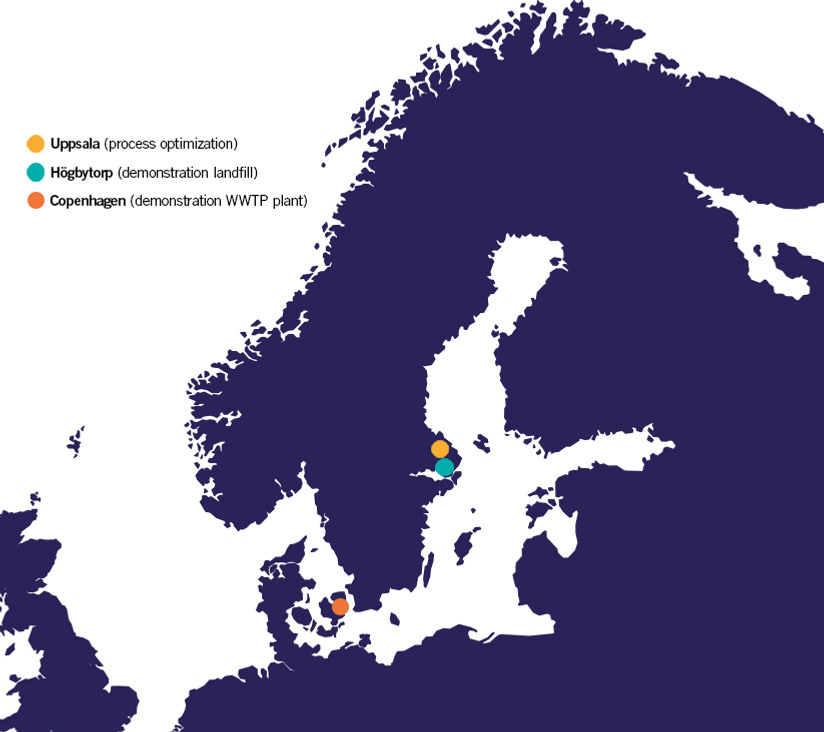Environmental problems targeted with the new process
Eutrophication
Greenhouse gas emissions
High resource consumption
High energy consumptin
Linear flow of nutrients
We believe that we have a solution that will make a great difference for the nitrogen cleaning and recovery industry. Read below why we believe it is needed, what our solution solve, and how we plan to make this happen.
Nitrogen is essential to life and is among the nutrients consumed in the largest quantities by all agricultural crops. However, today's linear flow of nutrients (nitrogen, phosphorus and potassium) from fertiliser manufacturing to wastewater treatment plant via food production and human consumption is not sustainable.
Humans and animals excrete a significant fraction of the nutrients contained in the food they ingest. Alongside other agricultural sources, these nutrients find their way back into the environment primarily as municipal wastewater effluents. Anthropogenic loading of nutrients is the main cause for eutrophication of receiving water bodies. Therefore, wastewater treatment plants (WWTPs) are needed for treating these nutrient rich effluents.
Both the manufacturing of mineral nitrogen fertilisers and the biological methods for wastewater treatment consume large amounts of energy and chemicals today. It also leads to emission of greenhouse gases and ammonia, which causes acidification and eutrophication.
Eutrophication
Greenhouse gas emissions
High resource consumption
High energy consumptin
Linear flow of nutrients
A circular solution for excess nutrients
Clean and high-quality commercial products
Reduction of climate emissions
Reduced resource and energy consumption
Integration into existing sewage treatment plant
Low financial investments
Simple process, equipment and control
Effective and robust process
The nitrogen treatment process in for example WWTPs requires massive aeration to oxidize all ammonium to nitrate. In order to obtain an efficient conversion of nitrate to nitrogen gas by de-nitrification an expensive source of carbon such as methanol is usually needed. The biologically process is both costly and sensitive to disruption. It also entails emissions of nitrous oxide, a powerful greenhouse gas which has an impact on the climate that is 300 times greater than carbon dioxide.
Traditional methods of purifying nitrogen usually release the nitrogen back into the air - instead of recycling it. Ammonia, the basic compound for the production of nitrogen fertilisers, is by far the largest reason of carbon footprint in cereal production. The ammonia production industry for manufacturing of mineral fertilisers relies heavily on natural gas as a non-renewable precursor for hydrogen and energy. To recycle the ammonia removed from wastewater streams can reduce the need of producing virgin ammonia.
We in the VA industry have for a long time been looking for different solutions to recover nitrogen from wastewater and if this is a successful result, we are facing an important breakthrough for nitrogen recovery.
Anders Finnson, Senior Environmental Advisor at Svenskt Vatten
Today, only a small proportion of nutrients, nitrogen, phosphorus and potassium, is returned from wastewater treatment plants to food production through application of sewage sludge to arable land. However, the largest problem is the sludge not used in agriculture but the sludge that today are landfilled or incinerated, if the nutrients in the sludge is not taken care of.
A logical conclusion is that nitrogen-containing effluents should be viewed as a nitrogen resource instead of a waste and nitrogen-containing effluents should be exploited through the recovery of nitrogen in forms that efficiently could be used in agriculture or other industries. This positive development is what this project aims to demonstrate.
The overall goal of the LIFE RE-Fertilizer project is to demonstrate a new, innovative and efficient process, patented by EasyMining, for removal and recovery of ammonium from aqueous flows. In the unique solution nitrogen is first captured by an precipitation chemical and separated from the wastewater. In the second step the captured ammonium is recovered in a conversion plant to a commercial viable product and the precipitation chemical is regenerated to be used in the process again.

Even if the project are focused in the Nordic area the market for implementation of the finalised, commercial solution is Europe and also worldwide. Removal and recovery of nitrogen from water with a high nitrogen concentration is a worldwide problem.
The international exchange is very important and EasyMinings´ nitrogen removal method is interesting around the world - in the OECD countries there are both treatment plants and increasing purification requirements.
Anders Finnson, Senior Environmental Advisor at Svenskt Vatten
In the same way as with the geographic scope, the industry scope is believed to be much larger than the scope for the project. The finalised commercial solution should be applicable to other water streams with a high nitrogen concentration than reject water in waste water treatment plants and leachate from landfills. Other areas where we see the solution is applicable for example animal manure and biogas fuel production.